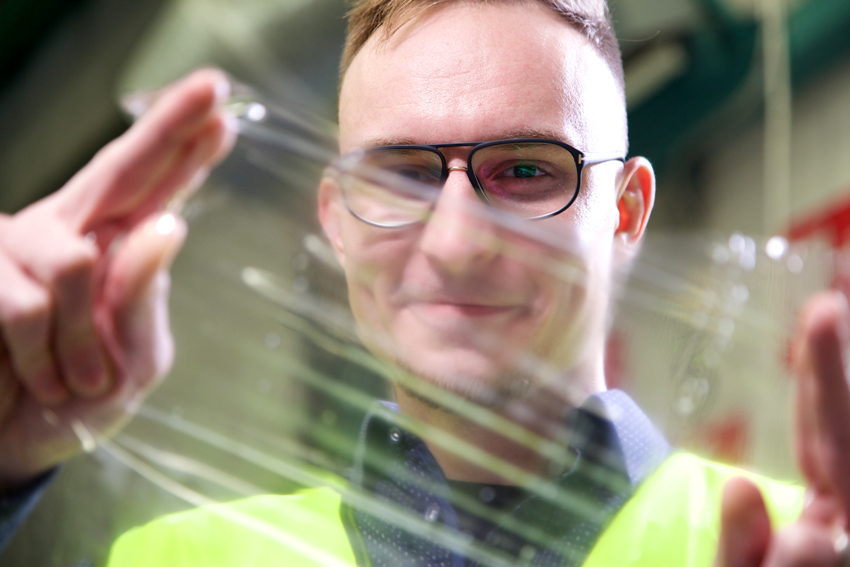13.12.2017 - Johannes Puro - Biodegradable plastic

– We have to reconsider a huge portion of the human activities if we want this planet to sustain for the future generations. If we zoom the scale close to the surface of the earth, we quickly run into the plastic waste problem: We are drowning to plastic, begins Jaakko Kaminen, the CEO of Welmu International Ltd.
The global plastic production reached 311 million tons in 2017 and is expected to rise to 1,24 billion tons prior to 2050. At the moment 26 million tons of the yearly output of packaging plastic ends up straight in the nature.
To understand the scale, one ton (2204 pounds) consist of million grams of plastic.
– In principle, plastic is a very useful material. It helps us for instance in reducing wastage. The challenge is that basicly the only way to get rid of plastic is by burning, Kaminen says.
“Basicly the only way to get rid of plastic is by burning”
There is already 9 billion tons of plastic somewhere in the surface of the earth. 6,3 billion tons of the amount has already transformed into plastic waste.
– Fixing the problem requires broad cooperation of nations, companies and other stakeholders. We are not able to give up the use of plastic any time soon, but the ways the material works and circulates can be developed. Ultimately, the focus has to be in decreasing the overall amount of plastic, Kaminen states.
The biggest single user of plastic is the packaging industry, which consumes 26 % of plastic globally. It produces the handy durable boxes that protect our goods and the thin films in which for instance flowers and leftovers are so easy to wrap.
However, significant proportion of the plastic packages are short-lived. At the same time the recycling of them is challenging.
In some countries the waste disposal functions, in others it doesn’t. Therefore one third of all plastic escapes recycling and ends up in the nature.
“In 2050 there is more plastic than fish in the oceans”
– The biggest threat is that the packaging plastic waste ends up in the oceans and forests. At the moment this happens with a speed of one truck load per minute. In 2050 there will be more plastic than fish in the oceans and growing amounts of it has ended up to our drinking water as micro plastic, Kaminen warns.
Yummy!
Jaakko Kaminen emphasizes that the growth of the plastic industry has had an enormous positive effect on the society and the economy. While the environmental drawbacks of the use of plastics, especially plastic packaging, have become clear, it is practically impossible to abandon the use of plastics entirely at this point.
– Nor do we need to. In fact, if we manage to rethink and transform the way we manufacture, use, reuse, recycle, and eventually dispose plastics, the plastic industry has a great future ahead of it.

Jaakko Kaminen and Senior Scientist Tommi Vuorinen checking Welmu International’s own plastic film. Research Technician Upi Anttila working in the background.
Kaminen refers to a multi-industry, global initiative led by Ellen MacArthur Foundation and McKinsey & Company, that has a vision of a sustainable New Plastics Economy.
It is based on three strategies differentiated by the market segment, as Kaminen lists:
– First of all, the biggest positive impact can be achieved by creating more effective, global after-use systems, which can make recycling economically attractive for about 50% of plastic packaging, measured by weight.
– The second part of the solution is to replace single-use packaging with reusable alternatives, which is economically attractive opportunity for about 20%.
– The third strategy for the last remaining 30% of plastic packaging is to fundamentally redesign and innovate packaging types, which do not have existing reuse or recycling pathway and are unlikely to have one in the near future.
This is the part of the waste that is likely to leak into the environment. These packaging items include for example nutrient contaminated and multi-material packaging.
One of the priority actions to accelerate the shift towards sustainable future of plastic packaging is to develop and scale up new materials based on renewable resources that will not cumulate in the ecosystem even if they escape the collecting systems.
“Welmu International is developing wood based, biodegradable plastic film material”
This is the field where Kaminen’s company, Welmu International, wants to make an impact. The company he manages is developing wood based, biodegradable plastic film material that has competitive technical properties in comparison to the traditional plastic film.
– The global plastic film market is estimated to exceed 125 billion USD by the year 2020. The market is massive, but fragmented. Hence, it is challenging to tackle the environmental drawbacks related to plastic films with one single innovation. Nevertheless, we see our material having the potential to challenge traditional plastic film in several segments with minor modifications to the recipe.
In their case, Welmu International has decided to base their material on wood for several reasons.
– First of all, we can get our feedstock from sustainably managed forest, the raw material is renewable and the resources basically unlimited. In addition, wood does not compete with the food chain like many other vegetable based bioplastics.
The demand for food in the world will grow 50% during the next decade, which is why sustainable companies do not want to occupy arable land to produce their feedstock.
– What is even more, is that our material has high technical properties in terms of strength and tear resistance and it can be manufactured with existing technology. This allows us to utilize the expertise of our partners in plastic film manufacturing, that have decades worth of experience and networks, which makes our business model highly scalable, Kaminen argues.

Sustainability is a collaborative effort. If you trace any value chain deep enough you will find the consumer as the last block of the chain, holding the ultimate power.
– It is the consumer who has the power to disrupt markets, make innovative ideas into reality and commercialize new products. All business is in the end downstream from the consumer demand. In consequent, the most compelling argument for any business venture is to validate that the consumer will purchase what the value chain delivers. Afterwards the consumer demand can be leveraged to scale the business, Kaminen reasons.
This is why Welmu International heads to the market consumer first. The company’s objective is to enter the market by launching their wood based cling film via supermarket chains European wide.
– In the bigger picture the necessary rethinking and change to sustainable plastic economy is impossible without collaborative effort of all the players across the global plastic packaging value chain. Our mission is to accelerate that change, Kaminen says.
Existing markets are never disrupted by the market-leading companies: it takes an outsider to bring the change. Welmu International is one of the promising cleantech innovators that has taken that role and bears the risk associated with it.
– We aim to realize our innovation in partnership with the market-leading companies, like multi national store chains to scale-up the positive environmental improvement as well as the profit, Kaminen finishes.
See Welmu International’s web pages >
Jaakko Kaminen on LinkedIn >
Related article: Plastic waste problem drives cosmetics manufacturers to use biodegradable packaging
Interviewee
Author

Leave comment - comments(0)